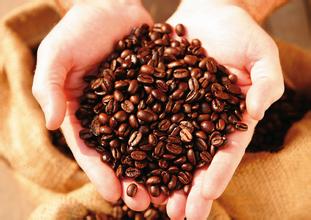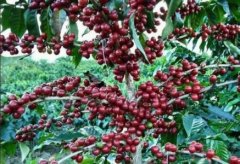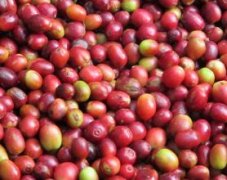Kenya washing AA grade Klinga producing area Kabarekong fish processing plant order baking boutique coffee

The fresh coffee fruits of this batch of Kong fish AA were picked and processed by 250 farmers in the Kongyu treatment plant under the jurisdiction of the Kabare farmers' cooperative. After peeling, fermenting and cleaning the coffee from the nearby Kongyu River, the coffee will be used in an African drying bed for drying. Every picking season, farmers deal with nearly 300 tons of fresh coffee fruit. After the processing is completed, it will participate in the coffee auction in Nairobi every Wednesday, which, once selected by legal exporters, will be shipped to consumer markets around the world.
In every Kenya before, we especially like to pursue those angular and strong acidity, and this Kenya makes me feel gentle, like facing the sea, with the feeling of breeze blowing.
Flavor description: strong dry and wet aromas of lemon and plum, shallow baking with a variety of amazing aromas such as flower and lemon, as well as the sour and sweet juicy of grapefruit green tea and citrus juice. slightly deepen the baking and then have a variety of flavors of honey and covered black plum, while the aftertaste is the pleasing sweet and sour taste of a lot of green tea.
Factory name: Qianjie Coffee Factory address: Guangzhou Yuexiu District Baoan Qianjie 10 Qianjie Cafe manufacturer contact Information: 020-38364473 shelf life: 90 net content: 227g packing: raw maturity of bulk coffee beans: whether coffee beans contain sugar: sugar-free origin: Kenyan coffee types: other roasting degree: light roasting
Country: Kenya
Grade: AA
Producing area: Klinaga producing area
Altitude: 1550-1750 m
Soil quality: red phosphate soil
Treatment method: Kenyan double washing treatment
Variety: SL 28, SL 34
Treatment plant: hole fish treatment plant
Producer: Kabare Cooperative
Flavor: grapefruit green tea, citrus, covered black plum
Kenya, located in East Africa, is one of the major coffee producing countries. More than 6 million people in the country are engaged in the coffee industry, mostly in the form of a combination of small farmers and cooperatives.
Coffee trees in Kenya are mostly planted at 1400 m-2000 m above sea level, and the growing areas include Ruiri, Thika, Kirinyaga and Mt. Kenya West, Nyeri, Kiambu and Muranga. Mainly in the foothills of Mt.Kenya and Aberdare.
There are many producing areas in Kenya that strive to preserve the native forest ecosystem, protect the natural gene pool, support the reproduction of wild coffee varieties and breed a variety of coffee trees.
In 1930, the unique Kenyan varieties SL28 and SL34, which were cultivated and named by the "Scott Laboratories" laboratory, were born in such a good environment.
According to botanists in SL laboratory, SL28 and SL34 are genetic variants. Among them, SL28 has a mixed pedigree of French missionaries, mochas and Yemens Tibica. The goal of cultivating SL28 was to mass produce coffee beans with high quality and resistance to diseases and insect pests.
Although the yield of SL28 was not as high as expected the copper leaf color and broad bean-shaped beans have great sweetness balance and complex flavor as well as significant citrus and black plum characteristics. SL34 is similar to SL28 in flavor, with a heavier, fuller and cleaner finish than SL28, except for the complex acidity and great sweetness of the finish. SL34 has French missionaries, bourbon, and more Tibica ancestry. Dou looks similar to SL28, but is more adaptable to sudden heavy rain. It is these two important varieties that lead us to the unique Kenyan style: strong acidity, rich taste and beautiful balance.
This Kenyan branch comes from the Kabare cooperative hole fish processing plant in Kenya's Krinyaga region. It grows in Manyata-Embu County on the eastern slopes of the Kenyan Mountains from 1550 to 1750. The variety is Kenya's classic SL28,SL34, coupled with the large temperature difference between day and night, and Kenya's red phosphate soil, making sweet and sour the main flavor tone of this Kenyan branch.
Important Notice :
前街咖啡 FrontStreet Coffee has moved to new addredd:
FrontStreet Coffee Address: 315,Donghua East Road,GuangZhou
Tel:020 38364473
- Prev

Costa Rican black honey treats Kadu Etala producing area Faramy Manor boutique single coffee bean Jane
We usually see the honey treatment methods are: yellow honey, red honey, black honey yellow honey: about 40% of the pectin is removed; the drying method requires the most direct heat absorption, receives the most light drying, and lasts for about 8 days to reach a stable water content. Red honey: about 25% of the pectin is removed; it takes longer to dry than yellow honey, and reduces the time spent in direct sunlight, even using
- Next

Front Street Fresh Roasted Panama Borquette 70% Rose Flower Butterfly Coffee Bean Introduction
Then in the land of Poquet, there is a bean with a particularly high cost performance. And it has a very beautiful name, Flower Butterfly. It has 40% of the high-quality rosewood pedigree, consisting of three varieties of rosewood, kadura and kaduai. It is planted in the Baru volcanic area of Poquet. It grows in the volcanic area at an altitude of 1600 meters. The treatment plant uses fine washing treatment. Panama native special
Related
- Detailed explanation of Jadeite planting Land in Panamanian Jadeite Manor introduction to the grading system of Jadeite competitive bidding, Red bid, Green bid and Rose Summer
- Story of Coffee planting in Brenka region of Costa Rica Stonehenge Manor anaerobic heavy honey treatment of flavor mouth
- What's on the barrel of Blue Mountain Coffee beans?
- Can American coffee also pull flowers? How to use hot American style to pull out a good-looking pattern?
- Can you make a cold extract with coffee beans? What is the right proportion for cold-extracted coffee formula?
- Indonesian PWN Gold Mandrine Coffee Origin Features Flavor How to Chong? Mandolin coffee is American.
- A brief introduction to the flavor characteristics of Brazilian yellow bourbon coffee beans
- What is the effect of different water quality on the flavor of cold-extracted coffee? What kind of water is best for brewing coffee?
- Why do you think of Rose Summer whenever you mention Panamanian coffee?
- Introduction to the characteristics of authentic blue mountain coffee bean producing areas? What is the CIB Coffee Authority in Jamaica?

